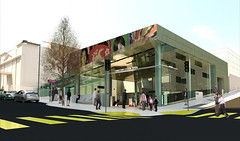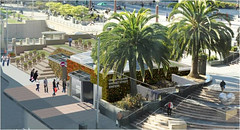Central Subway FAQs: Muni impacts, ridership, funding and more
With support from Washington and continued progress on construction and contracts, the Central Subway Project has accomplished major milestones in recent months. More achievements – including a commitment from the Federal Transit Administration (FTA) to provide nearly $1 billion in New Starts funding – are on the horizon, paving the way for tunneling and station construction to begin this year.
Extending Muni’s T Third Line through SoMa and into Union Square and Chinatown will benefit thousands of San Franciscans and vastly improve the Bay Area’s transportation network. The Central Subway will reduce travel times for residents, workers and visitors traveling through a congested corridor that has long been in need of improved public transit.
We on the Central Subway team believe it is important to provide useful, relevant information to the public about the project as it continues to advance. We have put together this blog post to answer questions that have arisen about the project’s costs, ridership, impacts on Muni and more.
Ridership
The T Third Line is expected to become Muni’s most heavily used light rail line soon after the Central Subway opens. It will travel through some of San Francisco’s most densely populated areas – and also through several areas that are expected to see remarkable population growth, including Mission Bay, Bayview/Hunter’s Point and Yerba Buena. More than half of San Francisco’s jobs and a significant proportion of projected job growth are located within the neighborhoods the T Third Line will serve. It will be an essential artery for travel around San Francisco, and also for connecting customers to the Bay Area’s transportation network.
- T Third Line ridership: By 2030, ridership on the T Third Line is projected to be about 20 percent higher than on the most heavily used existing Muni line, the N Judah Line. About 65,000 customers per day are projected to ride the T Third Line in 2030.
- Central Subway ridership: The Central Subway is expected to attract extremely high usage compared to other light rail projects around the country (see the table below). Only the Downtown Subway in Los Angeles is projected to have more daily boardings per mile in 2030. For just the Central Subway portion of the T Third Line, ridership in 2030 is projected at 35,100 daily boardings.
- Ridership in 2019: Ridership projections for the entire T Third Line are 43,700 for the Central Subway’s opening year.
Table: FY 2030 Daily Boardings per Mile for Light Rail Projects around the Country
| U.S. Light Rail Projects | State | 2030 Avg. Daily Boardings* | Route Miles | Daily Boardings per Mile |
|---|---|---|---|---|
| Los Angeles, Regional Connector, Downtown Subway | CA | 88,200 | 1.9 | 46,421 |
| SFMTA, T Third Phase 2 (Central Subway) | CA | 35,100 | 1.7 | 20,647 |
| Seattle, University Link | WA | 40,200 | 3.1 | 12,968 |
| Vancouver, Columbia River Crossing | WA | 21,400 | 2.9 | 7,379 |
| Houston, North Corridor | TX | 29,000 | 5.2 | 5,577 |
| Houston, Southeast Corridor | TX | 28,700 | 6.5 | 4,415 |
| St. Paul – Minneapolis, Central Corridor | MN | 40,900 | 11.0 | 3,718 |
| Mesa, Central Mesa Extension | AZ | 11,900 | 3.1 | 3,839 |
| Portland, Milwaukie Project | OR | 22,800 | 7.3 | 3,123 |
| Sacramento, South Sacramento Corridor Phase 2 | CA | 10,000 | 4.3 | 2,326 |
| Charlotte, Northeast Corridor | NC | 23,800 | 10.6 | 2,245 |
| Dallas, Northwest / Southeast | TX | 45,900 | 21.0 | 2,186 |
| Salt Lake City, Draper | UT | 6,800 | 3.8 | 1,789 |
| Salt Lake City, Mid Jordan | UT | 9,500 | 10.6 | 896 |
*http://www.fta.dot.gov/publications/reports/reports_to_congress/planning…
Impacts on Muni
The Central Subway will vastly improve Muni service for customers traveling along the busy 4th Street and Stockton Street corridors. Currently it takes more than 20 minutes – and sometimes much longer – during peak travel times to go from Caltrain to Chinatown on the Muni 30 Stockton or the 45 Union/Stockton. The route is crowded, and buses are consistently packed to capacity. The Central Subway will complete this 1.7-mile trip in just eight minutes. It will also be able to accommodate expected increases in ridership.
When the Central Subway opens to the public in 2019, it will not increase Muni fares, and its impacts on existing Muni service and the SFMTA operating budget will be modest:
Service:
- Service on most Muni bus routes will not be affected by the opening of the Central Subway. The only exception is the 30 Stockton’s short route. This route runs between the Caltrain Station and North Point and Van Ness. It will be eliminated once the Central Subway opens because the Central Subway will cover almost the exact same route.
- No service reductions are planned for the full 30 Stockton route, which runs between Caltrain and the Marina. The same is true for the 45 Union/Stockton, the 8X/8AX/8BX Bayshore Express and the other routes that operate along the Central Subway alignment.
Fares:
- Claims that fares will increase as a result of funding the Central Subway are without merit. Funding for the project comes from federal, state and local sources, not from the SFMTA’s operating budget.
- Even if the SFMTA does issue revenue bonds, the revenue bonds that would be issued would come from sources already included in the SFMTA’s budget. No increase to the operating budget would be required to issue bonds.
Operating budget:
- The Central Subway, with its 35,100 projected daily boardings, will increase the SFMTA’s annual operating budget by less than 0.25 percent. When the Central Subway opens to the public in 2019, it is expected to increase the SFMTA’s overall operating budget by $1.76 million. By 2030, the cost of operating the subway is projected to be $6.89 million. These numbers are included in the FY2012 New Starts submission.
- The challenges that the SFMTA faces with regard to its operating budget are driven by current budgetary challenges and not by the addition of much-needed rail service.
Cost
Constructing a new subway beneath a vibrant urban core like downtown San Francisco is a lot of work, and it requires a major investment. Included in the cost of the Central Subway Project are a number of major construction components, including tunneling under a densely populated urban area, constructing three subway stations and a surface-level station, installing operating systems and train tracks, purchasing new light rail vehicles and planning and administering the project.
Here is more information about the Central Subway’s estimated cost:
- The earliest project cost estimate of $647 million was based on an early conceptual engineering plan. The estimate served as a placeholder until a more accurate cost could be calculated. Accounting for inflation, this estimate equals $995 million in 2011 dollars.
- The current cost estimate increased to $1.6 billion for the following reasons:
- The proposed project alignment changed from 3rd Street to 4th Street, and the tunneling method changed from shallow tunneling to deep tunneling. These changes will result in faster travel times for Central Subway customers, a quicker construction timeline and reduced surface disruption during construction. During the preliminary engineering phase, an in-depth cost analysis incorporating these changes increased the cost estimate.
- The FTA performed a risk assessment on the project as part of the New Starts process. They recommended increasing the cost estimate by $200 million to allow for additional cost- and schedule-related contingencies. The SFMTA’s baseline budget for the Central Subway Project has remained at $1.578 billion since the addition of these FTA-recommended contingencies.
- The cost per mile of building the Central Subway is less than half the cost per mile of New York City’s two subway projects.
- When taken together, the per mile cost of constructing both phases of the T Third Line will be significantly less than light rail projects in Los Angeles and Seattle that also include a subway component.
FTA: Cost per Mile of New Starts Projects with Subway Segments
*http://www.fta.dot.gov/publications/reports/reports_to_congress/planning_environment_12279.html
Revenue Bonds
- The contingency funding plan approved by the SFMTA Board and the Board of Supervisors is just that: a contingency plan.
- Revenue bonds would be issued only in the following scenario:
- The $61 million in state High Speed Rail Connectivity funds are delayed or the project receives less of these funds than expected.
- The contingency funds budgeted for the project to cover unexpected costs or schedule delays are used. In total, $200 million is budgeted to cover contingencies.
- The Federal Transit Administration (FTA), which is expected to provide nearly $1 billion in funding to the Central Subway Project through its New Starts program, requested this additional assurance as part of its stringent review process.
We encourage you to contact us with any questions you may have about the Central Subway Project. You can reach us at central.subway@sfmta.com or by phone at 415-701-4371.
For timely updates on construction and project progress, you can find us on Facebook (www.facebook.com/centralsubway) and Twitter (www.twitter.com/central_subway).








One Response to “Central Subway FAQs: Muni impacts, ridership, funding and more”